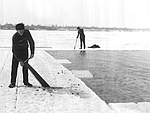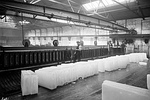Rockland County's Own Ice Age
Not many exploitable natural resources can be touted as being infinitely renewable, clean and beneficial to public heath. Ice had all of this going for it and in 1863, Rockland county, specifically the Knickerbocker Ice Company, exported 200,000 tons of the commodity. Harvested from Rockland Lake and cut into fourinch- thick blocks, only half of the 400,000 tons harvested made it to its final destinations. The pure water of Rockland Lake, an abundance of sawdust from local mills to be used as insulation and its proximity to the Hudson River made it ideal for harvesting ice and storing it in specially designed ice houses. What really made this location successful was that it was 200 feet above sea level with a short, gentle and most importantly — downhill — trip to the barges and ships that would take the melting blocks as close as New York City and as far away as the Caribbean.
The man who is credited with creating a business from frozen water is Frederic Tudor. Eventually becoming known as the “Ice King,” Tudor bought a ship in 1806, filled it up with 80 tons of ice and set sail for Martinique. When he arrived people were confused and he found that nobody had much interest in his cargo, most of it eventually melting into the sea. Seeing the potential was easy but he knew he would have to create the market. Tudor set out to teach restaurants how to make ice cream and doctors how to treat patients suffering from fever. By 1847 he was exporting 52,000 tons of the cold cargo; 180 tons even made it as far away as Calcutta, India. Even Henry David Thoreau’s journal captured Tudor’s men harvesting ice from Walden Pond, poetically romanticizing that "The sweltering inhabitants of Charleston and New Orleans, of Madras and Bombay and Calcutta, drink at my well."
Knickerbocker Ice Company was set up in 1831 in Congers, NY, and by 1869 it became one of the largest ice companies in the world after buying out its rival for an unheard sum of 1.1 million dollars. At its pinnacle it employed over 3,000 local residents along with a fleet of steam boats and barges to move the ice down river.
In 1896, the Knickerbocker Ice Company was at the center of a massive scandal involving fixing the price of ice, which at this time had stopped becoming a luxury and was considered a necessity. Collusion led to a doubling of the cost of the commodity. When investigators visited Rockland Lake they found the ice houses filled but nobody to load the product onto the barges. It was discovered that a labor dispute between the management and employees went unresolved on purpose and smaller companies that continued to supply ice at an inflated rate had deals with Knickerbocker that effectively let it profit without needing to pay for a labor force.
The decline of the industrial ice age began with the introduction of electricity in the early 1900’s. Advances in refrigeration technology led to more reliable domestic appliances and by the 1920’s the electric ice box had become a standard kitchen appliance, officially ending the need for the cumbersome process of harvesting ice. Knickerbocker cut its last block of ice from Rockland Lake in 1924 but its legacy was preserved in 1963 when the Palisades Interstate Park Commission acquired most of the company property, eventually becoming Rockland Lake State Park. Today people skate on the ice instead of harvesting it.



